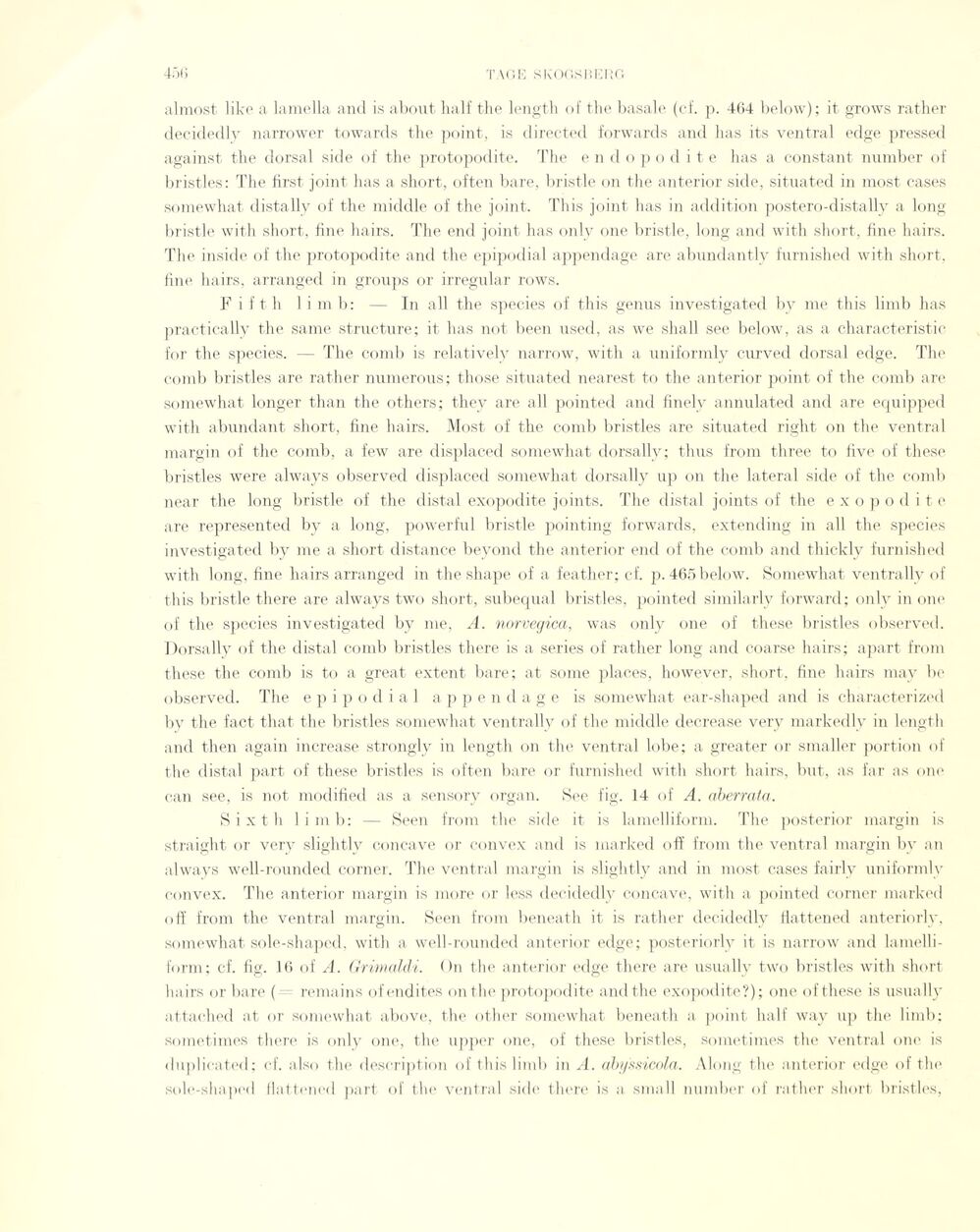
Full resolution (JPEG) - On this page / på denna sida - Sidor ...

<< prev. page << föreg. sida << >> nästa sida >> next page >>
Below is the raw OCR text
from the above scanned image.
Do you see an error? Proofread the page now!
Här nedan syns maskintolkade texten från faksimilbilden ovan.
Ser du något fel? Korrekturläs sidan nu!
This page has never been proofread. / Denna sida har aldrig korrekturlästs.
almost like a lamella and is about half the length of the basale (cf. p. 464 below); it grows rather
decidedly narrower towards the point, is directed forwards and has its ventral edge pressed
against the dorsal side of the protopodite. The endopodite has a constant number of
bristles: The first joint has a short, often bare, bristle on the anterior side, situated in most cases
somewhat distally of the middle of the joint. This joint has in addition postero-distally a long
bristle with short, fine hairs. The end joint has only one bristle, long and with short, fine hairs.
The inside of the protopodite and the epipodial appendage are abundantly furnished with short,
fine hairs, arranged in groups or irregulär rows.
F i f th li mb: — In all the species of this genus investigated by me this limb has
practically the same structure; it has not been used, as we shall see below, as a characteristic
for the species. — The comb is relatively narrow, with a uniformly curved dorsal edge. The
comb bristles are rather numerous; those situated nearest to the anterior point of the comb are
somewhat longer than the others; they are all pointed and finely annulated and are equipped
with abundant short, fine hairs. Most of the comb bristles are situated right on the ventral
margin of the comb, a few are displaced somewhat dorsally; thus from three to five of these
bristles were always observed displaced somewhat dorsally up on the lateral side of the comb
near the long bristle of the distal exopodite joints. The distal joints of the exopodite
are represented by a long, powerful bristle pointing forwards, extending in all the species
investigated by me a short distance beyond the anterior end of the comb and thickly furnished
with long, fine hairs arranged in the shape of a feather; cl p. 465 below. Somewhat ventrally of
this bristle there are always two short, subequal bristles, pointed similarlv forward; only in one
of the species investigated by me, A. norvegica, was only one of these bristles observed.
Dorsally of the distal comb bristles there is a series of rather long and coarse hairs; apart from
these the comb is to a great extent bare; at some places, however, short, fine hairs may be
observed. The epipodial a p p e n d a g e is somewhat ear-shaped and is characterized
by the faet that the bristles somewhat ventrally of the middle decrease very markedlv in length
and then again inerease strongly in length on the ventral lobe; a greater or smaller portion of
the distal part of these bristles is often bare or furnished with short hairs, but, as far as one
can see, is not modified as a sensory organ. See fig. 14 of A. aberrata.
Sixth limb: — Seen from the side it is lamelliform. The posterior margin is
straight or very slightly concave or convex and is marked off from the ventral margin by an
always well-rounded corner. The ventral margin is slightly and in most cases fairly uniformly
convex. The anterior margin is more or less decidedly concave, with a pointed corner marked
off from the ventral margin. Seen from beneath it is rather decidedly flattened anteriorly,
somewhat sole-shaped, with a well-rounded anterior edge; posteriorly it is narrow and
lamelliform; cf. fig. 16 of A. Grimaldi. On the anterior edge there are usually two bristles with short
liairs or bare (— remains ofendites on the protopodite and the exopodite?); one of these is usually
attaehed at or somewhat above, the other somewhat beneath a point half way up the limb;
sometimes there is only one, the upper one, of these bristles, sometimes the ventral one is
duplicated; cf. also the description of this limb in A. abyssicola. Along the anterior edge of the
sole-shaped flattened part of the ventral side there is a small number of rather short bristles,
<< prev. page << föreg. sida << >> nästa sida >> next page >>